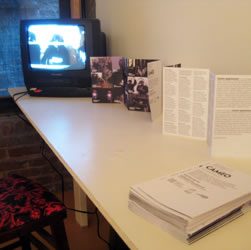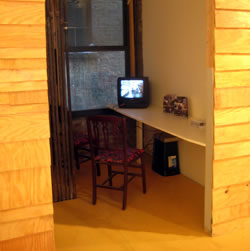


Matthew Higgs Society Reading Room
Cameo (April 23 - June 6, 2010)
Tadeusz Kantor, Pawel Kwiek, Piotr Uklanski, Krzysztof Bednarski, Zbigniew Warpechowski, Jozef Robakowski, Jan Swidzinski, Zuzanna Janin, Akademia Ruchu, Wojciech Bruszewski, Waclaw i Leslaw Janiccy, Jaroslaw Flicinski, Edward Krasinski
Guest Curated by Lukasz Ronduda, curator of film/video art at the Center for Contemporary Art, Warsaw, this exhibition was realized without the permission of the artists and without their actual artwork. It consisted of snippets from unrelated films in which Polish artists have had bit or walk-on parts over the past 50 years. Most took the parts early in their careers solely for mercenary puposes and never considered them to be their artistic work or that they would ever be presented in a fine art context. The thirty-minute film was presented on a single monitor.
The exhibition was alternately funny, smart, and poignant. Some of the acting parts required the actors to be animated and silly, producing an image of them that contrasts markedly with their more serious artistic personas. Moreover, seeing the artists so marginalized within such a popular medium encouraged one to see the exhibition as either a critical comment on the relative insignificance of fine art, or the collusion between the artists and their big-box-office nemesis. Finally, because the exhibition consisted of no actual artwork and its meaning was derived largely through its thoughtful assemblage, the authorial spotlight is cast back upon the curator himself.
On the occasion of "Cameo"'s original presentation at the Center for Contemporary Art in Warsaw last summer, Ronduda wrote:
"In film terminology, a cameo appearance, or just a cameo, is a brief appearance by a known person in a work of the performing artists, such as a motion picture. This film brings together a dozen or so such appearances by outstanding Polish artists, chiefly from the avant-garde movement. Cameo shows well-known artists busy, as part of their eccentric performances, seducing the viewer with costume, dialogue, psychology, anecdote, or expressive acting, that is, all that they despised in the space of art. Cameo offers an at-once suggestive and perverse vision of a fulfillment of the avant-garde dream of ultimately doing away with art's autonomy. Similarly, for the curator/director, Cameo as an exhibition/film, is an attempt to redefine the modes of working with the artist/actor and their work. Cameo tries to criticize the roles we play in daily life, to blur the distinct lines of classification that define art and hinder its freedom."


